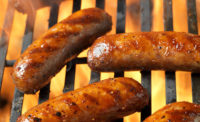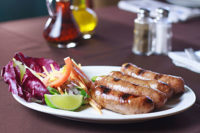Sausage isn’t usually thought of as being trendy. But last year, charcuterie — a preservation process for meat invented before refrigeration but now used for strong flavor — got quite a bit of press as an upcoming artisanal trend. It hasn’t gone mainstream just yet with sausages. However, the good ol’ standard sausage showed stability once again and even increased dollar sales.
The reason for sausage’s stability may actually be due to opposing interests — health vs. indulgence — that in the end cancel each other out.
“On one side, you see health becoming more important to consumers as sausage — like bacon — is perceived as an unhealthy option,” says Kelly Weikel, senior consumer research manager, Technomic Inc., a consulting and research firm based in Chicago. “Menu and consumer data from Technomic’s The Breakfast Consumer Trend Report shows some declines for both, which may be driven by health. At the same time, we’re seeing more options offer sausage substitutes at breakfast and increased interest in these choices, especially among younger consumers.”
On the other hand, a backlash against healthy products has been brewing for a while, and some consumers now seek indulgent, comfort foods, which sausage suits quite well, she says.
Dinner sausage dollar sales at retail, in fact, increased 1.9 percent to $3 billion, and unit sales increased 2.8 percent to 825.2 million pounds, according to Chicago-based IRI Group (as of Dec. 1, 2013). Breakfast sausage and ham dollar sales increased 5.4 percent to $1.5 billion, and unit sales increased 5.1 percent to 459.5 million pounds, as well.
“I think there are opportunities for sausage in terms of consumers wanting something a little bit different — and sausage isn’t seen on the menu as much as something like bacon — and wanting to see interesting flavors and combinations,” says Weikel. “With sausage there is really a lot you can do with it terms of creating a complex flavor profile. A good example of both of these is Dunkin Donuts’ smoked sausage breakfast sandwich. It’s different from breakfast sandwiches offered elsewhere and has an interesting spicy/sweet/smoky profile.”
Quality matters
Whether the sausage is healthy or indulgent, quality is always a critical ingredient in appealing to consumers.
“Sausage — especially encased ones — tends to have a lower quality profile because it is lumped with other things like hot dogs, which might lead to consumers questioning and not knowing exactly what it is that they are eating,” says Weikel. “But the more upscale-positioned sausage product like charcuterie, or [one] with a narrative that tells what it is and where it is from, can help ease consumer concerns.”
According to Julia Gallo Torres, category manager of US Foodservice Report, Mintel Group, a market-research firm based in Chicago, the top three flavors for sausage at restaurants are smoked, seasoned and barbecue. “Consumers still want flavor in a rich, hearty meal with a savory feel,” she says. “Barbecue indicates to them a slower prep, which ties into the comfort of ordering sausage.”
Indeed, the most common preparations at foodservice today are links, patties, sliced, chopped, ground and crumbled, she notes.
“There’s been a significant rise in fast-casual pizza restaurants, and the fast-casual segment is known for its better quality and health,” says Gallo Torres. “Sausage benefits from this association.”
Sausage is certainly versatile and is popping up on other menus as crumbles in a crunchy gravy for a (better than) home-cooked feel, chopped and added to potato pancakes with scrambled eggs for breakfast, or served as turkey sausage patties with eggs in a skillet, she notes.
A typical sausage, egg and cheese breakfast sandwich, for example, can be found 35 times at 26 chains for roughly $3.65, according to Technomic’s 2012-2013 MenuMonitor and 2013 The Breakfast Consumer Trend Report. Indeed, sausage can be found in breakfast sandwiches 39.5 percent of the time, compared to 40.5 percent for bacon, noted the report. In addition, consumers who are 35 years old or older would consider purchasing pork sausage 70 percent of the time for breakfast at a restaurant or store, compared to 57 percent for the 18- to 34-year-old crowd.
Tim Horton’s, for one, has a new Turkey Sausage Breakfast Sandwich, along with sausage in its Flatbread Breakfast Panini and Breakfast Wraps. “Millenials like fast-casual restaurants and like to eat smaller portions, so they naturally gravitate to higher-protein items,” says Gallo Torres.
Cracker Barrel is appealing to the high-protein crowd with its Double Meat Pancake Breakfast, which features smoked sausage patties, turkey sausage and bacon, sliced bacon, pancakes and eggs, she says.
“The most popular types of sausage are traditional, pepperoni and Italian sausage,” says Gallo Torres. “But it is a flexible ingredient, and can be used in wraps, sandwiches and gravies, just to name a few.”
In the last three years, the most growth has been seen in turkey sausage, Andouille, salami and chorizo.
“Turkey sausage is one of consumers’ favorite foods that they don’t want to give it up,” she says. “Chorizo and Andouille mirror the rise in hot and spicy flavors, while salami has spice and bite to it.”
Sausage is a popular protein at breakfast, but as operators begin to look beyond the traditional items, sausage has taken a hit.
“While its strength is certainly its popularity and familiarity with patrons, familiarity can also be a hurdle when operators begin to experiment and look beyond the traditional,” says Maeve Webster, senior director, Datassential, a Chicago-based market research firm. “Additionally, sausage has experienced some pullback as healthier or better-for-you options become more prevalent, and as consumers try to eat healthier overall and at the breakfast day-part. In fact, sausage seems to be doing better at lunch and dinner, where it’s acting as an ingredient in a wide range of items from sandwiches to pizzas and pasta.”
Sausage as an entrée can be found 23 times on menus at 11 limited-service chains for about $9.27, and 18 times at 16 full-service chains for $12.62, according to Technomic’s 2011-2013 MenuMonitor and 2013 The Center of the Plate: Beef & Pork Consumer Trend Report.
Better-for-your health and pocketbook
According to Mintel’s “Hot Dogs and Sausages” April 2013 report, the $8.2 billion hot dog and sausage segment is expected to grow progressively from 2013 to 2017, due to high consumption in households with children and in African-American households.
It seems that even picky children will try a sausage or hot dog, particularly if they are 6 to 8 years old. The report noted that households with children younger than 18 are more likely than others to eat sausages (80 percent compared to 74 percent) and hot dogs (86 percent vs. 79 percent). However, as the children’s population will not grow as fast as older generations from 2013 to 2018, sausage companies will have to appeal to other demographic groups with healthier options in the next few years, for example.
The report noted that 89 percent of black respondents report eating sausages, compared to 75 percent of white respondents, 60 percent of Asian respondents and 77 percent of Hispanic respondents. But the growth of the African-American population is not expected to rise as quickly as that of Asian-Americans and Hispanics.
The report also noted that a still-recovering economy is helping sausage and hot dog sales: Nearly one-third of respondents said sausages are an affordable meal, while 43 percent said hot dogs were affordable, as well. Until consumers feel comfortable with their spending power, they will look for more reasonable meal choices such as sausages and hot dogs.
Yet, data show that consumers often talk a good game in terms of health demands, but their pocketbooks sign a different tune. In Mintel’s report, shoppers said they were interested in all natural (50 percent), low sodium (41 percent), low or no meat filler content (39 percent), low fat (38 percent) and low/no nitrates/nitrites (36 percent).
More than half, however, say there is nothing wrong with indulging in fatty foods from time to time, while six in 10 eat foods despite their calorie count. Nevertheless, brands wisely offer healthier choices, such as Ball Park’s 50 percent lower-fat hot dogs and Johnsonville’s better-for-you sausages.
According to Roger Williams, president, Williams Sausage Co., based in Union City, Tenn., sales have been really strong again this year, particularly for healthier sausages.
“From our retail customers [for our private-label products], we are seeing a lot of interest in all-natural, antibiotic-free sausages,” says Williams. “Another big trend is turkey sausage. Healthy sausage sounds like a misnomer, but we’re seeing more interest. My gut feeling is younger consumers are more interested in sausage, since sales are increasing while the population is getting older.”
He thinks this interest in turkey and all-natural sausage will extend to fully cooked patties and links, as well.
“We will see the health trend reach convenience foods like breakfast sandwiches,” says Williams. “Fully cooked sausage is growing more rapidly than raw.”
And raw sausages are featuring more exotic flavors, similar to their foodservice counterparts. Williams sees increased interest in stronger flavors like maple syrup, chorizo and taco flavored and chipotle.
“Last year, as an example, we offered jalapeno and cheddar brats and sweet Italian dinner sausage,” he explains. “And our Southern customers are also more interested than before in brats and dinner sausages, most likely due to increased marketing efforts.”
Promote new flavors
According to Mintel’s report, flavor may just be the key to the continuing growth of the sausage segment. Almost 3 in 10 hot dog and sausage eaters said they would like to try unique flavors. Also, about 46 percent said they would like to see more premium/organic sausages at retail, as well.
Holmes Smokehouse Pecan Smoked Sausage on a Stick and Guy Fieri Smoked Sonoma Wine Country Pork Sausages are some of the new, flavorful product choices for consumers.
The National Hot Dog & Sausage Council noted that dinner sausage sales peak in the summer, and according to Mintel’s hot dog and sausage report, that represents one-third of annual sales. Therefore, promotions and advertising strategies, like in-store product tastings and recipe demos, should remain an essential component of summer marketing efforts.
Outdoor BBQ grills that offer shoppers new, freshly cooked samples could also encourage them to buy sausages once they get inside the store.
Breakfast sausage sales do best during the holidays, incidentally, and therefore, in-store tastings and recipe demonstrations will also help increase sales for them as well, the report noted.





Report Abusive Comment